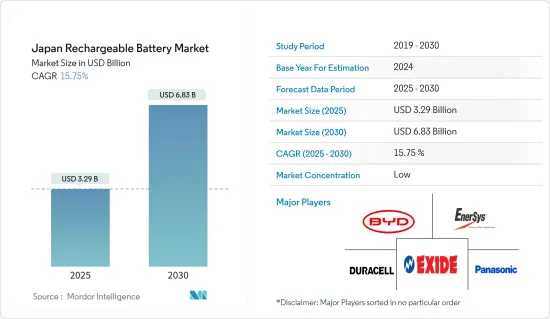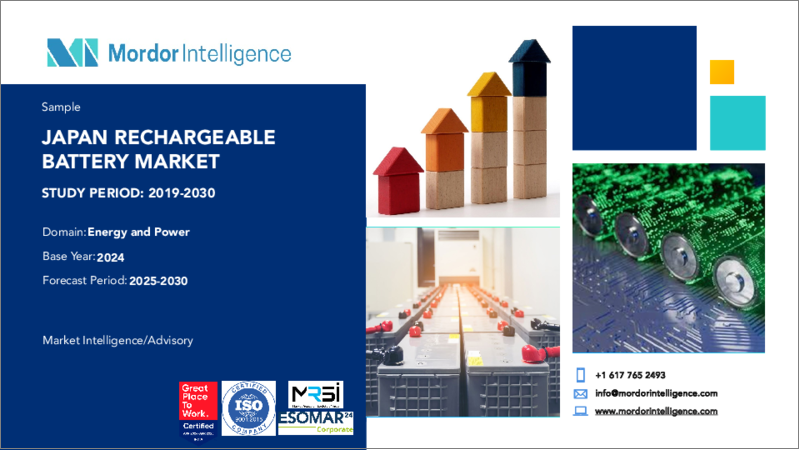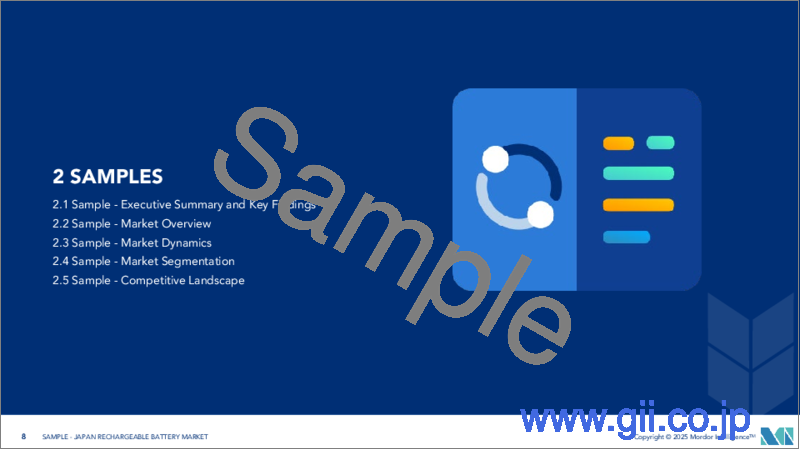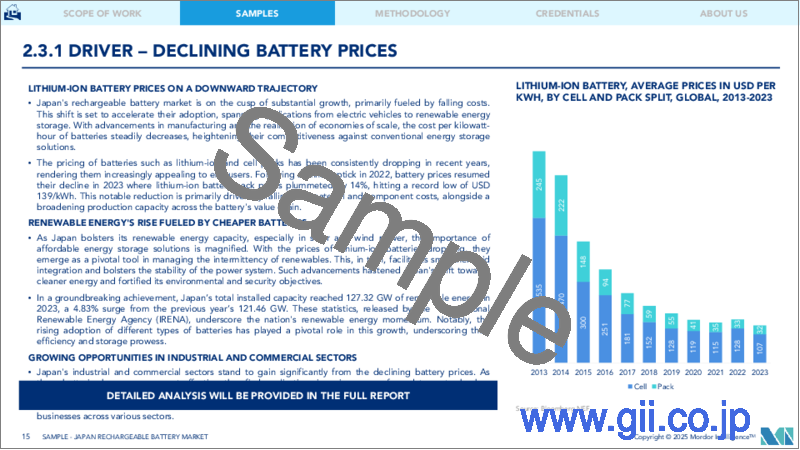|
|
市場調査レポート
商品コード
1636557
日本の二次電池:市場シェア分析、産業動向・統計、成長予測(2025~2030年)Japan Rechargeable Battery - Market Share Analysis, Industry Trends & Statistics, Growth Forecasts (2025 - 2030) |
||||||
カスタマイズ可能
適宜更新あり
|
|||||||
価格
| 日本の二次電池:市場シェア分析、産業動向・統計、成長予測(2025~2030年) |
|
出版日: 2025年01月05日
発行: Mordor Intelligence
ページ情報: 英文 100 Pages
納期: 2~3営業日
|
- 全表示
- 概要
- 目次
概要
日本の二次電池市場規模は2025年に32億9,000万米ドルと推定され、予測期間(2025~2030年)のCAGRは15.75%で、2030年には68億3,000万米ドルに達すると予測されます。

主要ハイライト
- 中期的には、電気自動車(EV)生産台数の増加とリチウムイオン電池価格の下落が、予測期間中の二次電池需要を牽引すると予想されます。
- 一方、原料の埋蔵量不足が日本の二次電池市場の成長を大きく抑制する可能性があります。
- スマートウォッチ、ワイヤレスイヤホン、スマートバンドなどのようなウェアラブルデバイスの採用が拡大しているため、近い将来、二次電池市場の参入企業にとって大きなビジネス機会が生まれると予想されます。
日本の二次電池市場動向
リチウムイオン電池タイプが市場を独占
- 多くの利点で知られるリチウムイオン二次電池は、様々なセグメントで広範な用途を見出しています。これらの電池は、電気エネルギー貯蔵のための信頼できる効率的なソリューションとして登場しました。リチウムイオン二次電池の際立った特長のひとつは、エネルギー密度が高いことで、コンパクトで軽量な形態に大容量の電力を詰め込むことができます。
- 日本のリチウムイオン二次電池市場はダイナミックな場であり、機会も課題もあふれています。有利な容量対重量比のおかげで、リチウムイオン二次電池は他の技術を凌駕して普及しています。リチウムイオン電池は通常、同種のものに比べて割高な値札が付いているが、市場の大手企業は研究開発に多額の投資を行い、事業を拡大しています。こうした競合の激化は、電池性能を向上させるだけでなく、リチウムイオン電池の価格下落動向にも寄与しています。
- 2023年には、電気自動車(EV)や電池エネルギー貯蔵システム(BESS)における電池パックの平均価格の上昇に牽引され、電池価格は顕著な下落を見せ、13%以上下落した139米ドル/kWhに落ち着いた。採掘・精製能力の増強に伴い、リチウム価格は安定し、2026年には100米ドル/kWhを目指すと予測されています。
- 多くの電池エネルギー貯蔵システム(BESS)の中心であるリチウムイオン電池は、その高いエネルギー密度、急速充電、サイクル寿命の長さで珍重されています。これらの特性は、BESS用途での効率的なエネルギー貯蔵と放出に非常に適しています。日本の企業は、今後数年間、BESSを強化するプロジェクトを積極的に推進しています。
- その一例として、2023年8月、日本の著名な電池メーカーであるPower Xは、地元の再生可能エネルギー開発会社であるWest Holdingsと提携しました。両社の合弁会社は、蓄電池システムと太陽光発電施設を全国に展開することを目指しています。2025年春の完成を目標に、2社は蓄電容量200MWh、太陽光発電出力30MWを達成する計画です。この構想は、地域の蓄電システムの強化を約束するだけでなく、急増するエネルギー需要に対応し、その結果、リチウムイオン二次電池のニーズを高めることにもなります。
- 日本の再生可能エネルギー、特に太陽光と風力への取り組みは、リチウムイオン二次電池の極めて重要な役割を強調しています。これらの電池は、再生可能エネルギーからの余剰エネルギーを利用・貯蔵し、天候の変化にもかかわらず安定した電力供給を確保するために不可欠です。
- あらゆる電源の中でも、太陽エネルギーが主役になります。日本は、原子力エネルギーへの依存を減らす戦略の一環として、2030年までに太陽光発電容量を108GW近くまで増やすという野心を持っており、近い将来、リチウムイオン電池の需要が急増することを示唆しています。
- こうしたプロジェクトやイニシアチブを踏まえると、リチウムイオン二次電池の需要は今後数年で急増する見込みです。
著しい成長を遂げる自動車セグメント
- 長い間、内燃機関車(ICE)が道路を支配してきました。しかし、環境への関心が高まるにつれ、電気自動車(EV)へのシフトが顕著になっています。EVの主流はリチウムイオン二次電池を利用したもので、エネルギー密度が高く、軽量で、自己放電が少なく、メンテナンスの必要性が低いことで有名です。
- プラグインハイブリッド車や電気自動車は、リチウムイオン二次電池システムを動力源としています。急速充電機能と高エネルギー密度により、リチウムイオン電池は、走行距離と充電時間に対するOEMの要求を満たす唯一の技術として際立っています。対照的に、鉛ベースのトラクション電池は、重量が重く、比エネルギーが低いため、フルハイブリッド車やEVには不向きです。
- 日本では最近、電気自動車の普及が著しいです。国際エネルギー機関(IEA)は2023年の電気自動車販売台数を14万台と発表しており、これは2022年比で44.3%の増加です。予測では、今後数年間で、この地域全体のEV販売台数が大幅に増加するとされています。
- 電気自動車と再生可能エネルギーを支持するため、日本政府は一連の施策とインセンティブを展開してきました。こうした取り組みがリチウムイオン電池の需要を高めています。2023年、政府はEVの生産を拡大し、二酸化炭素排出ゼロへの道を促進する野心的な計画を発表しました。
- 日本政府は「電動化自動車戦略2050」を導入し、2050年までに日本の自動車メーカーが生産する全車両のEVへの完全移行を目標としています。さらに、日本のEV充電インフラ情勢の下で、Tokyo Electric Power Company Holdingsは、2025年までに高速道路の急速充電器を1,000台に増やすことを決めています。
- さらに、国際社会が持続可能性に軸足を移すなか、日本もこの電気革命を心から受け入れています。東京都は、2030年までに公共の充電ポイントを3万カ所から15万カ所に増やすことを目標としています。このような協調的な努力により、日本はEVの生産、ひいてはリチウムイオン電池の需要を高める態勢を整えています。
- このような積極的な対策により、この地域ではEVの販売と充電インフラが盛んになり、その結果、予測期間における二次電池の需要が増加すると予想されます。
日本の二次電池産業概要
日本の二次電池は半分断されています。主要企業(順不同)には、BYD Company Ltd.、Duracell Inc.、Exide Industries Ltd.、EnerSys、Panasonic Holdings Corporationなどがあります。
その他の特典
- エクセル形式の市場予測(ME)シート
- 3ヶ月間のアナリストサポート
目次
第1章 イントロダクション
- 調査範囲
- 市場の定義
- 調査の前提
第2章 エグゼクティブサマリー
第3章 調査手法
第4章 市場概要
- イントロダクション
- 2029年までの市場規模と需要予測(単位:米ドル)
- 最近の動向と開発
- 政府の規制と施策
- 市場力学
- 促進要因
- 電気自動車(EV)生産の増加
- リチウムイオン電池価格の下落
- 抑制要因
- 原料の埋蔵量不足
- 促進要因
- サプライチェーン分析
- PESTLE分析
- 投資分析
第5章 市場セグメンテーション
- 電池タイプ
- リチウムイオン電池
- 鉛蓄電池
- その他の技術(NiMh、Nicdなど)
- 用途
- 自動車用電池
- 産業用電池(動力用、据置型(テレコム、UPS、エネルギー貯蔵システム(ESS)など))
- ポータブル電池(民生用電子機器製品など)
- その他
第6章 競合情勢
- M&A、合弁事業、提携、協定
- 主要企業の戦略
- 企業プロファイル
- BYD Company Ltd
- Duracell Inc.
- EnerSys
- Panasonic Holdings Corporation
- Energizer
- Saft Groupe SA
- Exide Industries Ltd
- Gotion High tech Co Ltd
- Murrata Manufacturing Co. Ltd.
- GS Yuasa International Ltd.
- その他の著名な企業一覧
- 市場ランキング/シェア分析
第7章 市場機会と今後の動向
- ウェアラブルデバイスの採用拡大
目次
Product Code: 50004063
The Japan Rechargeable Battery Market size is estimated at USD 3.29 billion in 2025, and is expected to reach USD 6.83 billion by 2030, at a CAGR of 15.75% during the forecast period (2025-2030).

Key Highlights
- Over the medium term, rising electric vehicle (EV) production and declining lithium-ion battery prices are expected to drive the demand for rechargeable batteries during the forecast period.
- On the other hand, the lack of raw material reserves can significantly restrain the growth of the Japan rechargeable battery market.
- Nevertheless, the growing adoption of wearable devices like smartwatches, wireless earphones, smart bands, and more are expected to create significant opportunities for rechargeable battery market players in the near future.
Japan Rechargeable Battery Market Trends
Lithium-Ion Battery Type Dominate the Market
- Lithium-ion rechargeable batteries, known for their numerous advantages, find extensive applications across various sectors. These batteries have emerged as a trusted and efficient solution for electrical energy storage. One of their standout features is their high energy density, allowing them to pack substantial power into a compact and lightweight form.
- Japan's lithium-ion rechargeable battery market is a dynamic arena, brimming with both opportunities and challenges. Thanks to their favorable capacity-to-weight ratio, lithium-ion batteries are outpacing other technologies in popularity. While lithium-ion batteries typically come with a premium price tag compared to their counterparts, leading market players are heavily investing in R&D and scaling up operations. This intensified competition has not only enhanced battery performance but also contributed to a downward trend in lithium-ion battery prices.
- In 2023, driven by rising average battery pack prices in electric vehicles (EVs) and battery energy storage systems (BESS), battery prices saw a notable dip, settling at USD 139/kWh-a drop of over 13%. With the ramp-up of extraction and refining capacities, lithium prices are projected to stabilize, aiming for USD 100/kWh by 2026.
- Central to many Battery Energy Storage Systems (BESS), lithium-ion batteries are prized for their high energy density, rapid charging, and extended cycle life. These attributes make them exceptionally suited for efficient energy storage and release in BESS applications. Companies in Japan are actively pursuing projects to bolster BESS in the upcoming years.
- As a case in point, in August 2023, Power X, a prominent Japanese battery manufacturer, teamed up with West Holdings, a local renewable energy developer. Their joint venture aims to roll out battery storage systems and solar power facilities nationwide. Targeting a spring 2025 completion, the duo plans to achieve a storage capacity of 200MWh and a solar output of 30MW. This initiative not only promises to bolster regional storage systems but also addresses the surging energy demand, subsequently driving up the need for lithium-ion rechargeable batteries.
- Japan's commitment to renewable energy, particularly solar and wind, underscores the pivotal role of lithium-ion batteries. These batteries are essential for harnessing and storing surplus energy from renewables, ensuring consistent power supply despite weather variations.
- Solar energy, among all sources, is set to take center stage. Japan's ambition to boost its solar capacity to nearly 108 GW by 2030, as part of its strategy to reduce nuclear energy reliance, signals a burgeoning demand for lithium-ion batteries in the near future.
- Given these projects and initiatives, the demand for lithium-ion rechargeable batteries is poised for an upswing in the coming years.
Automobile Segment to Witness Significant Growth
- For a long time, vehicles with internal combustion engines (ICE) dominated the roads. However, as environmental concerns grow, there's a noticeable shift towards electric vehicles (EVs). Predominantly, EVs utilize lithium-ion rechargeable batteries, celebrated for their high energy density, lightweight nature, minimal self-discharge, and low maintenance needs.
- Plug-in hybrids and electric vehicles are powered by lithium-ion battery systems. Thanks to their rapid recharge capability and high energy density, lithium-ion batteries stand out as the sole technology meeting OEM demands for driving range and charging time. In contrast, lead-based traction batteries fall short for full hybrids or EVs, given their heftier weight and lower specific energy.
- Japan has seen a remarkable surge in electric vehicle adoption recently. In 2023, the International Energy Agency (IEA) reported sales of 140,000 electric vehicles, marking a 44.3% increase from 2022. Projections indicate a significant uptick in EV sales across the region in the coming years.
- To champion electric vehicles and renewable energy, the Japanese government has rolled out a suite of policies and incentives. These initiatives have bolstered the demand for lithium-ion batteries. In 2023, the government unveiled ambitious plans to ramp up EV production and expedite the journey to zero carbon emissions.
- Japan's government introduced the Electrified Vehicle Strategy 2050, targeting a complete transition to EVs for all vehicles produced by Japanese automakers by 2050. Additionally, under Japan's EV Charging Infrastructure Landscape, Tokyo Electric Power Company Holdings is set to increase rapid highway chargers to 1,000 units by 2025.
- Moreover, as the global community pivots towards sustainability, Japan is wholeheartedly embracing this electric revolution. The Tokyo government aims to amplify public charging points from 30,000 to 150,000 by 2030. With these concerted efforts, Japan is poised to boost EV production and, consequently, the demand for lithium-ion batteries.
- Given these proactive measures, it's anticipated that EV sales and charging infrastructure will flourish in the region, subsequently driving up the demand for rechargeable batteries in the forecast period.
Japan Rechargeable Battery Industry Overview
The Japan rechargeable Battery is semi-fragmented. Some of the key players (not in particular order) are BYD Company Ltd, Duracell Inc., Exide Industries Ltd, EnerSys, and Panasonic Holdings Corporation, among others.
Additional Benefits:
- The market estimate (ME) sheet in Excel format
- 3 months of analyst support
TABLE OF CONTENTS
1 INTRODUCTION
- 1.1 Scope of the Study
- 1.2 Market Definition
- 1.3 Study Assumptions
2 EXECUTIVE SUMMARY
3 RESEARCH METHODOLOGY
4 MARKET OVERVIEW
- 4.1 Introduction
- 4.2 Market Size and Demand Forecast, in USD till 2029
- 4.3 Recent Trends and Developments
- 4.4 Government Policies and Regulations
- 4.5 Market Dynamics
- 4.5.1 Drivers
- 4.5.1.1 The Increasing Electric Vehicle (EV) Production
- 4.5.1.2 Declining Lithium-ion Battery Prices
- 4.5.2 Restraints
- 4.5.2.1 Lack of Raw Material Reserves
- 4.5.1 Drivers
- 4.6 Supply Chain Analysis
- 4.7 PESTLE Analysis
- 4.8 Investment Analysis
5 MARKET SEGMENTATION
- 5.1 Battery Type
- 5.1.1 Lithium-ion Battery
- 5.1.2 Lead-Acid Battery
- 5.1.3 Other Technologies (NiMh, Nicd, etc.)
- 5.2 Application
- 5.2.1 Automotive Batteries
- 5.2.2 Industrial Batteries (Motive, Stationary (Telecom, UPS, Energy Storage Systems (ESS), etc.)
- 5.2.3 Portable Batteries (Consumer Electronics, etc.)
- 5.2.4 Other Applications
6 COMPETITIVE LANDSCAPE
- 6.1 Mergers and Acquisitions, Joint Ventures, Collaborations, and Agreements
- 6.2 Strategies Adopted by Leading Players
- 6.3 Company Profiles
- 6.3.1 BYD Company Ltd
- 6.3.2 Duracell Inc.
- 6.3.3 EnerSys
- 6.3.4 Panasonic Holdings Corporation
- 6.3.5 Energizer
- 6.3.6 Saft Groupe SA
- 6.3.7 Exide Industries Ltd
- 6.3.8 Gotion High tech Co Ltd
- 6.3.9 Murrata Manufacturing Co. Ltd.
- 6.3.10 GS Yuasa International Ltd.
- 6.4 List of Other Prominent Companies
- 6.5 Market Ranking/ Share Analysis
7 MARKET OPPORTUNITIES AND FUTURE TRENDS
- 7.1 Growing Adoption of Wearable Devices
お電話でのお問い合わせ
044-952-0102
( 土日・祝日を除く )






